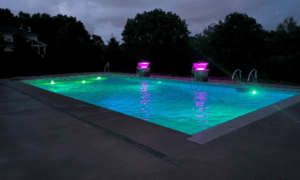An Infrared light emitting diode (IR LED) is a device that emits light that resides in the invisible electromagnetic spectrum. It can be divided into IR receiver LED, infrared emitter, Photodiode, etc. Because of this specific property and many others, Infrared LEDs are useful in a number of different applications, including remote controls for TVs, infrared security cameras, grow lights, and more. This article explores how IR LED light differs from regular LED, its various wavelengths, applications, and more.
Differences Between Regular LED and IR LED
There are several key differences between regular LED and IR LED lights. These include the following:
- Wavelength: Regular LEDs emit light in the visible light wave domain from 380nm to 700nm. On the other hand, infrared LEDs emit light in the invisible range of the electromagnetic spectrum. The wavelength range is 780nm-1mm.
- Visibility: Regular LEDs emit visible light to the naked eye. Infrared LEDs emit light that exists beyond the visible spectrum. Therefore, it is invisible to the naked eye.
- Applications: The difference in wavelength and visibility gives regular LEDs and IR LEDs different applications. Regular LEDs are used to illuminate the space around us. They also provide lighting for CCTV cameras. IR LED illuminators are used in grow lighting, remote controls, infrared security cameras, and more.
Different IR LED Wavelengths and Their Applications
IR LED light resides in the invisible wavelength range of the electromagnetic spectrum. Depending on the wavelength, IR LED illuminators become suitable for different applications. Following are the common wavelengths of infrared LED light and their corresponding applications:
- 940nm: Infrared LEDs featuring this wavelength are suitable for remote controllers for household applications, detection sensors, face detection, and more.
- 870nm: This wavelength of infrared lighting is suitable for video cameras in crossroads and the marketplace.
- 850nm: Infrared LEDs with 850nm wavelength are commonly used in video cameras that are applied in theftproof alarm systems, door phones, monitoring systems, and digital photography.
- 840nm: This wavelength is ideal for waterproof colored zoom infrared video cameras.
- 830nm: IR LED light featuring this wavelength is used in automated card reader systems.
- 808nm: This infrared wavelength is suitable for infrared illumination, space optical communication, and medical treatment appliances.
850nm vs. 940nm IR LED Lighting
Although there are many IR LED light wavelengths, 850nm and 940nm are the two most commonly used ones. Hence, they are always compared with each other. These particular wavelengths have several key differences. These include the following:
- Light Glow: 850nm wavelength has a faint red glow that is visible at direct exposure. However, it is still not visible to the naked eye. 940nm, on the other hand, has no such glow, and it is completely invisible.
- Sensitivity: Most true day/night cameras that use IR filters have high sensitivity to 850nm wavelength, but this is not the case with 940nm wavelength. Only a handful of cameras are sensitive to this wavelength.
- Illumination: 940nm wavelength has a shorter illumination range as compared to 850nm.
- Radiation Intensity: 850nm has about 2-3x higher radiation intensity as compared to 940nm. The higher radiation intensity leads to higher brightness.
- Service Life: Generally, 850nm has a longer service life than 940nm.
Conclusion
Overall, infrared LED light offers lots of unique advantages that are not possible to achieve via regular LEDs. It serves various industries, and it is suitable for a wide range of applications. No matter what your requirement may be, choosing a reliable IR manufacturer is crucial to ensure a hassle-free experience. Refond is one such supplier you can rely on to cover all your IR LED lighting needs at a reasonable IR LED price. They carry a large selection of IR LED strips that support the most popular and commonly used infrared wavelengths, including 940nm, 850nm, 750nm, and more. They can help you satisfy your specific needs no matter whether you buy IR LEDs for growing plants, security cameras, or detection systems.
Visit their website to browse their wide range of infrared product offerings.



































